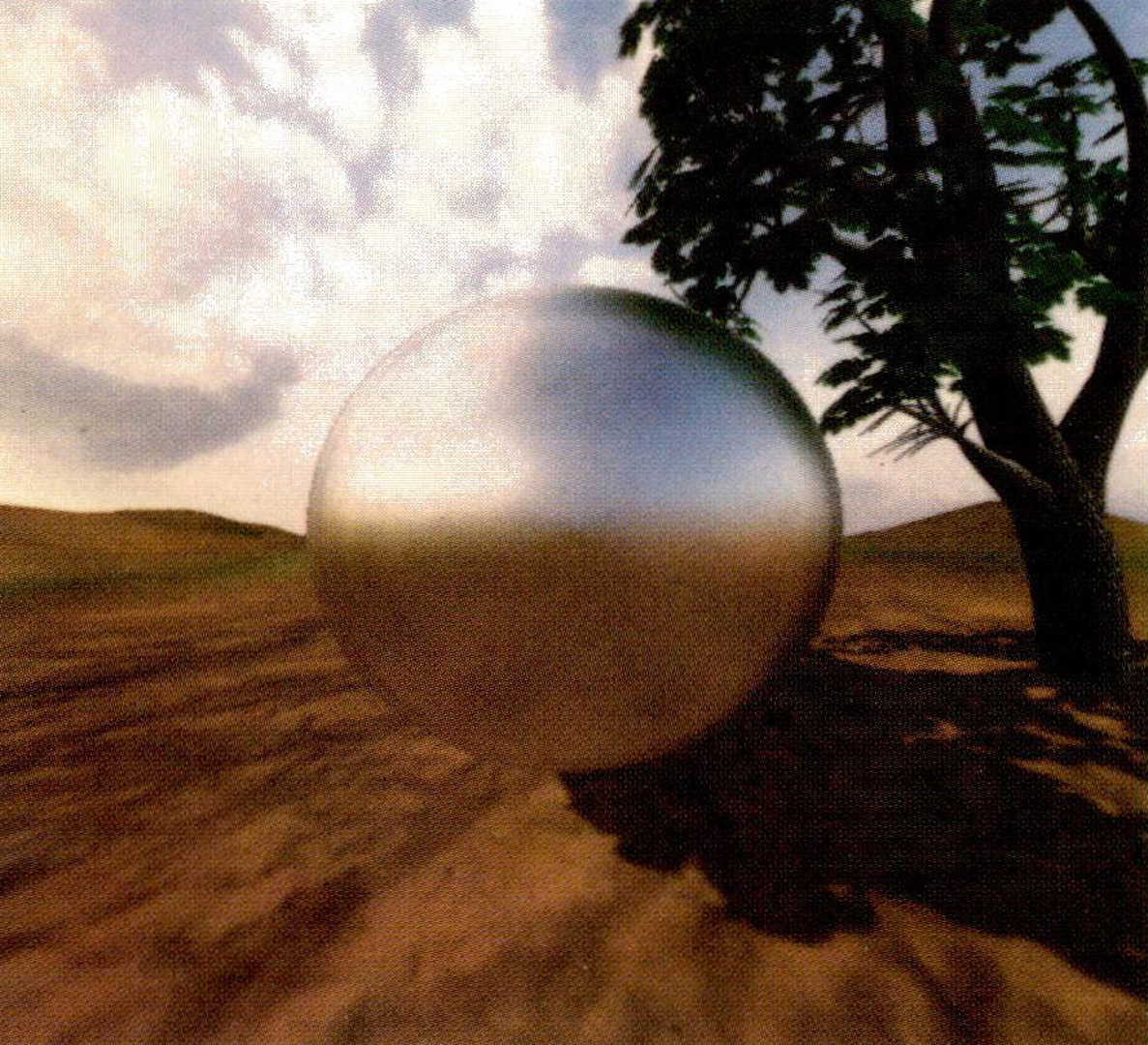“Bidirectional reflection functions from surface bump maps” by Cabral, Max and Springmeyer
Conference:
Type(s):
Title:
- Bidirectional reflection functions from surface bump maps
Presenter(s)/Author(s):
Abstract:
The Torrance-Sparrow model for calculating bidirectional reflection functions contains a geometrical attenuation factor to account for shadowing and occlusions in a hypothetical distribution of grooves on a rough surface. Using an efficient table-based method for determining the shadows and occlusions, we calculate the geometric attenuation factor for surfaces defined by a specific table of bump heights.Diffuse and glossy specular reflection of the environment can be handled in a unified manner by using an integral of the bidirectional reflection function times the environmental illumination, over the hemisphere of solid angle above a surface. We present a method of estimating the integral, by expanding the bidirectional reflection coefficient in spherical harmonics, and show how the coefficients in this expansion can be determined efficiently by reorganizing our geometric attenuation calculation.
References:
1. Blinn, James. Models of Light Reflection for Computer Synthesized Pictures. Proceedings of SIGGRAPH ’77 (San Jose, California, July 20-22, 1977). In Computer Graphics 11, 2, (July 1977), 192-198.
2. Blinn, James. Simulation of Wrinkled Surfaces. Proceedings of SIG- GRAPH ’78 (Atlanta, Georgia, August 23-25, 1978). In Computer Graphics 12, 3, (August 1978), 286-292.
3. Bllnn~ James, and NeweU, Martin. Tezture and Reflection in Computer Synthesized Pictures. Comm. ACM. Vol. 19, No. 10, pp. 542-547. 1976.
4. Born, Max, and Wolf, Emil. Principles of Optics. Pergamon Press. Oxford 1980
5. Bresenham, 3. E. Algorithm for computer control of a digital plotter. IBM Systems Journal. Vol 4. pp. 25-30. 1965.
6. Catmull, Edwin~ and Rom, Raphael. A Class of Interpolating Splines, in Computer Aided Geometric Design. Barnhill and Pdesenfeld, Eds. Academic Press, pp. 31%326. New York.1974.
7. Cook, Robert, Porter, Thomas, and Carpenter, Loren. Distributed Ray Tracing. Proceedings of SIGGRAPH ’84 (Minneapolis, Minnesota, July 23-27, 1984). In Computer Graphics 18, 3, (July 1984)~ 137-145.
8. Cook, Robert and Torrance, Kenneth. A Reflectance Model for Computer Graphics. Proceedings of SIGGRAPH ’81 (Dallas, Texas, August 3-7, 1981). In Computer Graphics 15, 3, (August 1981), 307-316.
9. Courant, R., and Hilbert, D. Methods of Mathematical Physics. Interscieuce Publishers, Inc., p. 513. New York. 1953.
10. Crow, Franklin. Summed-Area Tables for Teztuve Mapping. Proeeedings of SIGGRAPH ’84 (Minneapolis, Minnesota, July 23-27, 1984). In Computer Graphics 18, 3, (July 1984), 207-212.
11. Duff, Tom. Compositing $-D Rendered Images. Proceedings of SIGGRAPH ’85 (San Francisco, California, July 22-26, 1985). In Computer Graphics 19j 3, (July 1985), 41-44.
12. Glassner, Andrew. Adaptive Precision in Tezture Mapping. Proceedings of SIGGRAPH ’86 (Dallas, Texas, August 18-22, 1986). In Computer Graphics 20, 4, (August 1986), 297-306.
13. Greene, Ned. Applications of World Projections. IEEE CG&A. Vol. 6, No. 11. pp. 21-29.1986.
14. Greene, Ned, and Heckbert, Paul. Creating Raster Omnimaz 1mages from Multiple Perspective Views using the Elliptical Weighted Average Filter. IEEE CG&A. Vol. 6, No. 6, pp. 21-27. 1986.
15. Hall, Roy, and Greenberg~ Donald. A Testbed for Realistic Image Synthesis IEEE Computer Graphics and Applications Volume 3, No. 8, pp. 10-20 1984
16. Heckbert, Paul. Filtering by Repeated Integration Proceedings of SIGGRAPH ’86 (Dallas, Texas, August 18-22, 1986). In Computer Graphics 20, 4, (August 1986), 315-321.
17. Helmholtz, H.v. Helmoltz’s Treatise on Physiological Optics. Optical Society Of America. Washington, D.C. 1924.
18. Immel, David, Cohen, Michael, and Greenberg, Donald. A Radiosity Method for Non-Diffuse Environments. Proceedings of SIG- GRAPH ’86 (Dallas, Texas, August 18-22, 1986). In Computer Graphics 20, 4, (August 1986), 133-142.
19. Kajiya, James. The Rendering Equation. Proceedings of SIG- GRAPH ’86 (Dallas, Texas, August 18-22, 1986). In Computer Graphics 20, 4, (August 1086), 143-150.
20. Kajiya, James, and Von Herren, Brian. Ra~l Tracing Volume Densit/es. Proceedings of SIGGRAPH ’84 (Minneapolis, Minnesota, July 23-27, 1984). In Computer Graphics 18, 3, (July 1984), 165-174.
21. Max, Nelson. Shadows for Bump Mapped Surfaces. Advanced Computer Graphics, T. L. Kunii, Ed. Springer Verlag, Tokyo. pp. 145-156. 1986.
22. Miller, Gene, and Hoffman, Robert. Illumination and Reflection Maps: Simulated Objects in Simulated and Real Environments. Advanced Image Synthesis Course Notes. Siggraph Conference. 1984.
23. Ohira, Tomohiro. A Shading Model for Anisotropic Reflection. Technical Report of The Institute of Electronics and Communication Engineers of Japan, in Japanese. Vol. 82, No. 235, pp. 47-54. 1983.
24. Perlin~ Kenneth. Course Notes. Siggraph Conference. 1984.
25. Perlin, Kenneth. Course Notes. SIGGRAPH ’85 State of the Art in Image Synthesis Seminar Notes. submitted to IEEE CG&A, and personal communication. 1986.
26. Phong, Bui-Tuong. Illumination for Computer Generated Images. Comm. ACM. Vol. 18, No. 6, pp. 311-17. 1975.
27. Reuse, W. A. Polarization Studies of Light Diffusely Reflected from Ground and Etched Glass Surfaces. J. Opt. Soc. Am. Vol 40, No. 1. pp. 55-59. 1950.
28. ” Snell, Jay. Radiometery and Photometery. Handbook of Optics. Driseoll, W. G. and Vaughen. W., Eds. McGraw-Hill. 1978.
29. Spangenberg, D. B., Strung, A. G., and Chamberlin, J. L. Surface Tezture Measumnents of Metal Surfaces National Bureau Standards, Special Publication 300 Vol 7. Washington, D.C. 1971.
30. Takagi, 3., Yokoi, S., and Tsurwoka, S. Comment on the Anisotropie Reflection Model. Bulletin of SIG. Graphics and CAD, Information Processing Society of Japan, in Japanese. Vol. 11. No. 1 pp. 2-9. 1983.
31. Tinkham, M. Group Theory and Quantum Mechanics. McGraw Hill pp.101-115. New York. 1964.
32. Torrance, Kenneth, and Sparrow, Ephraim. Theory for Off- Specular Reflection .from Roughened Surface. Journal of the Optical Society of America. Volume 57 No. 9 1967.
33. USA Standard Nomenclature and Definitions for Illuminating Engineering. USAS Z7.1-1967. 1967.
34. Whitted, Turner. An Improved Illumination Model for Shaded Display. Comm. ACM.’Vol. 23, No. 6, pp. 343-349. 1980.
35. Whltted, Turner, and Cook, Robert. A Comprehensive Shading Model. Image Rendering Tricks Course Notes. Siggraph Conference. 1985.
36. Williams, Lance. Pyramidal Parametries. Proceedings of SIG- GRAPH ’83 (Detroit, Michigan, July 25-29~ 1983). In Computer Graphics 17, 3, (July 1983), 1-11.





